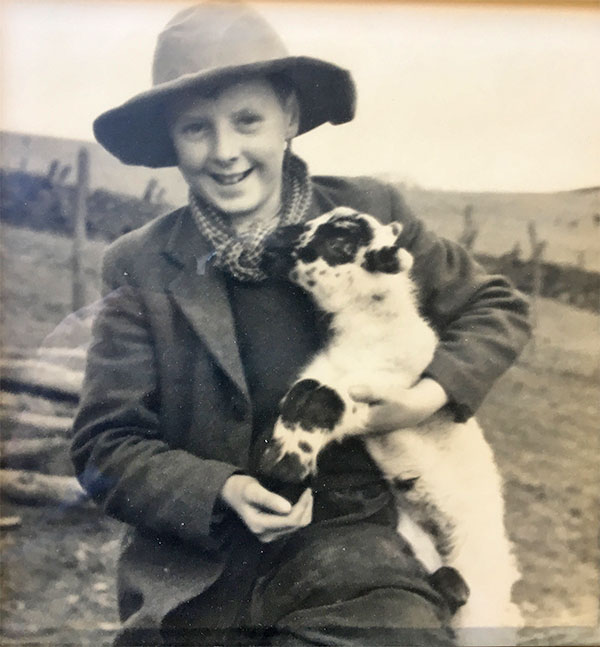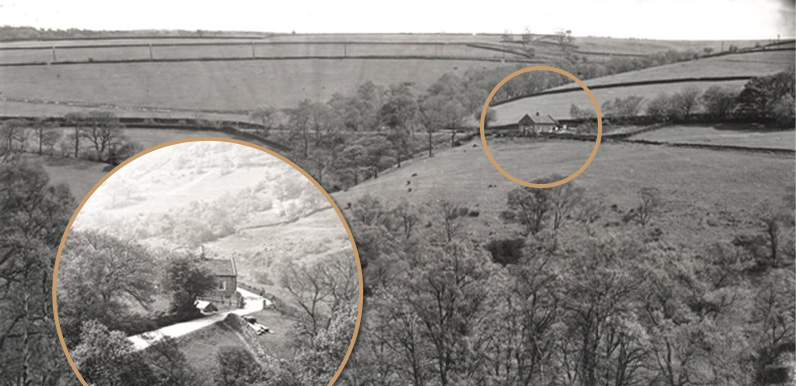Above: One of the very few buildings in the valley that Bill doesn’t recognise.
The Long Hill road is easily identified by the line of telegraph poles in the distance. The dark stripe running horizontally below is the disused track of the C&HPR.
And it’s just possible to make out the slope of The Valentine on the left, between the two, as it descends from Fernilee into the valley.

Above: nine-year-old Bill caring for a motherless lamb at Oldfield Farm in 1952.
76-year-old Bill Brocklehurst knows the Goyt Valley extremely well. He was brought up first at Normanwood Farm, and then Oldfield Farm. At 16, his father told him he would be a shepherd, and that his first task was to go down the fields and cut a branch to use as a crook.
So when his son, Alec, told me Bill would be happy to go through the collection of 1930s photos and help identify where they were taken, I leapt at the chance. And soon we were sharing a pot of tea and examining old maps of the valley.
I thought I’d managed to successfully caption about three-quarters of the 100 or so photos, leaving around 25 still to do. But it soon became clear that my confidence had been sadly misplaced.
Bill knows the area so well that he can quickly identify buildings and locations by the shape of fields, contours in the land, and trees in the landscape.
We went through all the photos identifying views and places I wasn’t sure about, and correcting those that I’d got completely wrong. But there were still a couple of places even Bill wasn’t sure about.
One of these is a building that looks like a domestic house at the foot of The Valentine, the lane leading up from the gunpowder mill to Fernilee. It’s close to where the lane crossed the track of the Cromford & High Peak Railway line.
This fade shows where Bill thinks it once stood; beside where the Valentine crossed the track of the C&HPR. And he wonders whether it may have been used to warn of approaching trains. And then converted to a house when the line closed in 1892.
Most of the traffic down the Valentine would have been workers traveling to and from the nearby gunpowder mill, as well as carts carrying materials. A collision between a train and a cart carrying gunpowder could have had explosive results!
Another theory is that this may have been the ‘Bottom Lodge’ that we’ve struggled to locate. Gerald Hancock, author of ‘Goyt Valley Romance’, wrote that ‘…a Mrs Pickup kept a shop here’.
I don’t know whether traffic from Goyt’s Bridge was allowed through the mill (it seems unlikely). But there may have been enough trade for a shop from passing gunpowder mill workers.
These are the photos showing the building. Click one to enlarge and then scroll through the collection. And please get in touch if you can add any information about the house. Or simply leave a comment below.
Page update: I finally managed to identify the mystery building; it’s Lower Lodge. Click here for more information.

I too grew up in Fernilee although I am a little younger than Bill. (That’s the first photo I’ve seen of him without a beard!)
This is most definitely Bottom – or Lower Lodge as it used to be called. In 1891 it was also described in the Census as Powder Mill Road Railway Crossing Bottom Lodge. Matthew Wilson lived there with his family and he was a Railway worker.
This section of the Railway closed the year after. I have always known it as Bottom Lodge. I presume it was there for the specific duty of making sure there were no collisions between Gunpowder and Rail, although there were not that many trains. But of course it must have had some input from the Grimshaws.
Some of the photos you have on the site are of The Hollows 40802, 40777, 36520. This was formerly known as Powder Mill Cottages. My Depledge ancestors were Coopers at the Powder Mill and lived here at one point,.
It was later knocked through to form one house when Bill Lomas lived there. He said there were two staircases and they used to go up one and down the other.
Bill Lomas and his family lived before that at Oldfield Farm, before George Brocklehurst. You have a picture of Bill Lomas as a small boy stood outside The opening of the Village Hall in Fernilee. The last family to live here were the Dugdales.
The picture of the Camp is in Taxal. It’s Manchester Scouts, the Jodrells Own. They still come every year to camp in the same place.